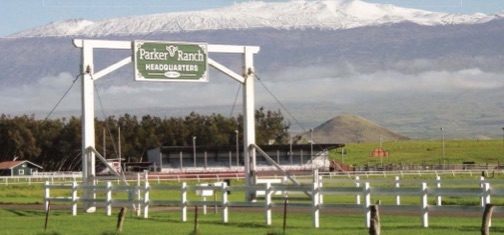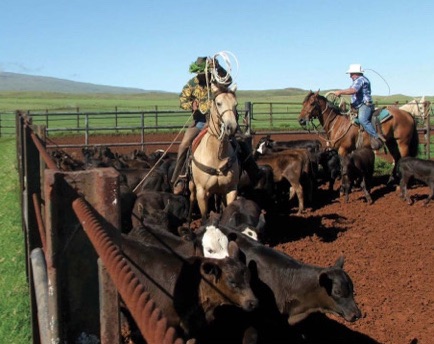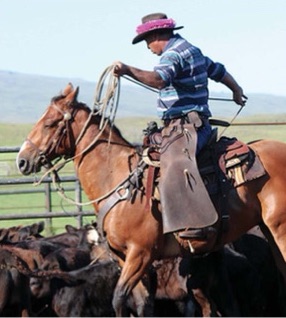Paniolo on the Parker Ranch
by Terri Mason
It was an outwardly innocent gift turned disastrous that gave rise to not only a unique culture, but one of the largest cattle ranches in the U.S. – the Parker Ranch of Hawaii.

Ancient Hawaii boasted no large land mammals, but in 1793, Captain George Vancouver presented a few cattle to King Kamehameha I (the monarch who fought to unite the islands under a single kingdom). The first cows and bulls fared poorly, either dying or were eaten. So when Vancouver landed additional cattle in 1794, he encouraged the King to place a kapu (ban) on hunting to allow the herd to grow.
Over a decade later, a seemingly unrelated event happened. In 1809 a 19 year old sailor named John Parker (1790-1868) jumped ship, determined to say on this tropical paradise. The enterprising young man came to the attention of the King, and John was hired as a keeper of the royal fish ponds. Parker left the island for a brief sojurn to China during the War or 1812, and then returned to Hawaii.
A year after Parker returned, he married the daughter of a high-ranking chief, chiefess Keli’skipikaneokaolohaka, who took the Christian name Rachael, and they began building a life together. Parker established a two-acre ranch on the slopes of Mauna Kea, buying the land from King Kamehameha III and later expanding it with his wife’s 640-acre inheritance.
In a relatively short span, the few protected cattle had grown into a huge problem. Now, some 25,000 head of wild mavericks roamed the island and had turned into a dangerous nuisance. They destroyed the natives’ crops, and hurt, attacked, and sometimes killed people. Something had to be done.

In 1830, King Kamehameha III (1824-1854) lifted the kapu and hired “bullock” hunters – some from as far away as Australia’s Botany Bay, plus some locals – including John Parker. In 1832, the King also sent one of his high chiefs to California to hire vaqueros who could round up wild cattle and teach Hawaiians cattle and horse handling skills. Three Mexican-Spanish vaqueros named Kossuth, Louzeida, and Ramon began working on Hawaii island, first training horses and then training Hawaiians to round up and cull the massive herds.

The vaqueros shared all their skills: horse training, roping, and cattle handling plus leather working and rawhide braiding.
Hawaiians proved themselves avid students, and Hawaii’s cowboys became known as paniolo, a corruption of espanol, the language the vaqueros spoke. Because Hawaiians began their work with cattle and horses much earlier than on the mainland, (cowboys in the Pacific Northwest got their start in 1846; in California and Texas it was 1848) there were paniolo long before there were cowboys.
The arrival of the bullock hunters and vaqueros also happened to coincide with an economic opportunity. In the early 1830’s, trade in sandalwood slowed as forests became depleted. At about the same time, whaling ships began wintering in Hawaiian waters. Ships reprovisioning in ports provided a market for salt beef in addition to hides and tallow. Ranching became commercially viable and, due to the King’s fortunate decision, the island already had the men in place to do the job.
As the cattle trade boomed, the paniolo became skilled in transporting cattle from land to sea. Before refrigeration, cattle were often shipped live to the Honolulu stockyards. Cowboys atop their horses swam cattle out through the surf to waiting longboats, which then rowed out to the steamer. Once alongside, the animals were hoisted aboard by a winch with a sling, and on deck the cattle’s horns were lashed to the railings.
As the Parker’s fortunes grew, so did the ranch and their family. Over the course of their marriage, Rachel parker bore a daughter and two sons to carry on the legacy.
Parker’s descendants continued to expand the ranch, eventually making it the largest ranch under individual ownership in the United States at the time with 225,000 acres and 50,000 cattle.

As the Parker Ranch grew, the highlands of Waimea became a bustling centre of trade. The Parker descendants ventured into other industry and the outfit needed a manager with business acumen. In 1887, Alfred Carter, a respected Honolulu businessman and judge, became Parker Ranch’s champion, guiding its growth with a steady and for nearly half a century.
The attack on Pearly Harbor drew the American into the World War, and from 1942-1945, Parker Ranch leased 40,000 acres to the military, rechristened Camp Tarawa, which served as a training base for some 50,000 Marines as they prepared for the battles of Iwo Jima and Okinawa.
After the war the last Parker heir, actor Richard Palmer Kaleioku Smart (1913-1992), modernized and diversified the ranch’s operation. In 1965 he leased land to Laurence Rockefeller for building the Mauna Kea Beach Hotel on Kauna’oa Bay. It was too dry for cattle, but popular with tourists. Smart also opened a visitors centre and museum. In 1979 he built the 490-seat Kahilu theatre (named after his mother’s Hawaiian name) in Waimea, on ranch land. In his will, Smart established the Parker Ranch Foundation Trust, created exclusively for health care, education, and charitable purposes for island residents.
Today, the ranch encompasses 135,000 acres of the Big Island. Parker Ranch is among the largest cattle ranches in the U.S., and known around the world as the home of the paniolo.
“Aloha, Pipi Wahine” translates as “Hello, female cattle”
Originally published in the February/March 2012 issue of Canadian Cowboy Country Magazine.












